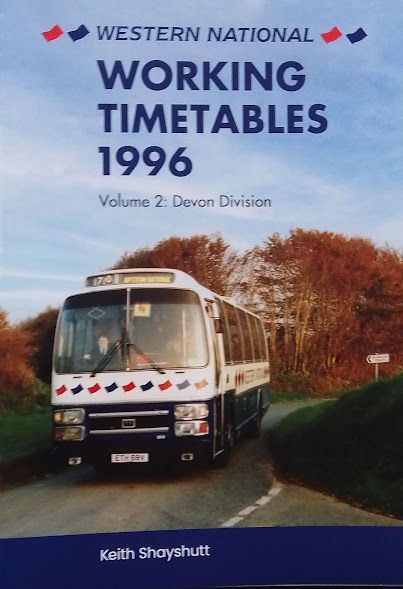But First, First
In what is something of a surprise, news breaks that First have signed an agreement to buy the business of Ensignbus, centred on Thurrock, Essex. This comes soon after First has announced a withdrawal from Southampton City and the sale of its Falkirk-based Scottish business.
Presumably, the idea is that Ensign will be a "good fit" with the First Essex business. Ensign is particularly well known for its preserved vehicles and some very popular "running days". It will be interesting to see what happens to these under the ownership of a very commercially minded national operator.
And, Talking Of First Bus ...Keith Shayshutt's book charts the operations of the Plymouth-based services of Badgerline's privatised Western National (WN) at the point of take-over by First Bus.
Historically, there had been an "agreement" between Plymouth Corporation Transport and the original Western National, which gave WN a share of services to the newly expanding areas of the growing border town. Eventually, First Bus sold its much reduced Plymouth operation to Stagecoach and that situation applies today.
So fbb is looking at the Stagecoach remnants of the wide ranging route network covered in the book and some of the expansion of City Bus, later sold on to GoAhead.
The Tamar Bridge opened to traffic in 1961, and was "officially" opened by the late Queen in 1962. So this allowed WN to develop busy routes across the bridge to Saltash. Here is a timetable extract from 1996.Services 1 and 2 ran every 7/8 minutes to Saltash, then alternate ways round a local loop (St Stephens, Latchbrook, Burraton) and vice versa.
Today the service is Stagecoach 2/2A ...... with two smaller route-specific loops. The service is halved in frequency ...With buses running through via Plymstock to Mount Batten ....
... or Elburton and Sherford.Plymstock always was an exclusive WN area and even now Stagecoach offers additional services 3 and 4 to the area. But City Bus has nudged in with its competitive route 5/5A.The 5 and 5A (alternate ways round a big loop) just nibble away at Stagecoach's supremacy.
... and approx every 30 min as service 7 to Mount Batten. The area has benefited from substantial extra housing since 1996.
Saltash Passage, for the ferry to Saltash, was once a Plymouth area tram route run by one of the three tram companies serving the community.Later this became a W N bus ...... as route 7. Confusing isn't it? Now it is City Bus 13!The other "trunk" out of town route now operated by Stagecoach is service 1 to Tavistock.This has recently been merged with the "George" Park and Ride running every 10 minutes, with a 20 minute frequency going on to Tavistock.The Park and Ride was formally Stagecoach 100 (and First 100 before that) ...... but has now lost its separate identity.
In 1996 Tavistock was an important WN route with numbers 83 and 84 giving a joint 30 minute headway, BUT ...... with some very complex variations, with suffix letters, particularly at peak times.
Clearly this has not been a full and detailed survey of the changes from 1996 to the present day - such would have been too complex and way beyond fbb's pay grade. Not all 1996 WN city routes have been covered, but enough to show the sorry decline from WN to First and some sort of stability under Stagecoach.
From the public's point of view, however, it is such a pity that you need two maps and two sets of leaflets (or even two searches on-line) to bring together Plymouth's local buses.
Surely there is a strong argument for franchising and/or a proper partnership so that the public can enjoy a fully coordinated bus service.
But it is far worse in the country area, as we shall see tomorrow.
One problem with Keith's otherwise excellent book is that there is no route maps for either Plymouth itself or the surrounding area. Perhaps the author would like fbb to draw one for the next edition?
Puzzle PictureYou probably guessed. fbb ordered a CDU to boost power to his recalcitrant solenoid driven point-in-a-tunnel. He chose the cheapest.
Unfortunately he erroneously chose a kit which he has to solder together rather than a made up thing.The chances of that happening successfully are less than nil. The chances of it happening at all are similar!
And there are no instructions. Presumably it is obvious!
Really?
Next Plymouth 1996 blog : Wednesday 15th February
























Meanwhile in Bournemouth, Christchurch and Poole (BCP) we see the last day of operation of XELA bus’s six month tender T/A Yellow Coaches. Tomorrow routes, 18, 33 & 36 will go to Morebus, as they did for about a week when Yellow Buses folded.
ReplyDeleteThe only non GSC route coming to BCP is First bus’s X54, Weymouth to Poole service.
Until very recently, Plymouth City is included most Stagecoach routes (let's face it, there aren't many!) on their own network map. Alas, this seems to not be the case any more.
ReplyDeleteUntil very recently Plymouth City Council published an (online) map of all bus routes, regardless of operator. Alas, this seems to not he the case any more.
Citybus, not City is....
ReplyDeleteEnsign's Heritage fleet is not part of the sale to First and, I understand, will remain with the Newman family
ReplyDeleteAn all-services bus map does still appear on the Plymouth City Council website, because - all together now - "It's all on line!"
ReplyDeleteThe 7/8 minute frequency to Saltash was served with Mercedes minibuses - previously it had been half-hourly with VRs (and it still is on Sundays/BHs!). The "bread vans" were a victim of their own success, and were soon replaced by "proper" buses on a 10 minute frequency (20 min each way round the loop). It's now a 15/30 mins service during the day.
ReplyDeleteOops! No, not VRs these days!
ReplyDelete